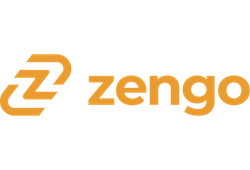
Over the recent years, cryptocurrency wallets have become a very popular topic to discuss, among the many different crypto enthusiast circles around the world. It’s no wonder, really - with the crypto industry booming now more than ever before, a huge number of newcomers are looking for the best wallet products out there. In their search, these individuals may stumble upon user Zengo wallet reviews.
Zengo is a “hot wallet” - more specifically, it’s a mobile app-based wallet that stores its user crypto funds within, and allows you to trade cryptos from the comfort of the wallet itself. Quite a few user Zengo reviews found online will tell you that the wallet in question is actually a rather unique product, as far as crypto storage is concerned.
We’ll cover all of this perceived uniqueness in the review ahead, and also talk about all that you need to know in order to decide whether or not Zengo is worth checking out. Let’s get straight to it, shall we?
Free Airdrop Season 7 is LIVE! Answer fun questions or do simple tasks to earn rewards from the $30K BitDegree prize pool. Participate Now ! 🔥
Pros
- No seed phrase to misplace or compromise
- Top-tier security
- In-wallet crypto swaps and purchases
- 24/7 customer support
- Free to use
Cons
- Some services are not available in select countries
Table of Contents
- 1. Zengo Wallet Review: PROS
- 1.1. A Non-Custodial Cryptocurrency Wallet
- 1.2. Major Emphasis on Security
- 1.3. Crypto Staking Functionality
- 1.4. Swap Cryptocurrencies Inside Your Wallet
- 1.5. Over 180 Supported Crypto Assets
- 1.6. Additional Features with Zengo Pro
- 2. Zengo Wallet Review: CONS
- 2.1. Certain Services Not Available in Some Countries
- 3. Zengo's Fee Model
- 4. How to Use Zengo?
- 4.1. How to Register on Zengo?
- 4.2. How to Send / Receive / Buy / Sell / Swap / Earn Cryptocurrencies on Zengo?
- 5. Conclusions
Zengo Wallet Review: PROS
To start off my Zengo wallet review, let’s cover some of the core benefits that you may expect to receive while using the wallet in question. Admittedly, there are actually quite a few interesting features to cover, too! One of the most evident of these is the fact that Zengo is a non-custodial wallet.
A Non-Custodial Cryptocurrency Wallet
Among the different industry jargon that you can often hear thrown around, “non-custodial” is a term that comes up rather often. This is especially true in regards to crypto wallets and exchanges - this Zengo wallet review is no exception, either.
What do “custodial” and “non-custodial” stand for? In layman’s terms, “custodial” refers to a crypto service ‘holding’ your wallet's private keys, and in turn, theoretically having access to your crypto assets, as well.
As opposed to that, non-custodial wallets put all of the responsibility in your hands - you are the only one that controls your own private keys. This is a bit more dangerous, since there are absolutely no guarantees on the wallet’s side of things, if something were to happen to your cryptos - all of the responsibility lies in your hands.
On the flip side, multiple Zengo reviews will tell you that this is actually the way to go. If you want to truly feel safe regarding your cryptocurrencies and crypto tokens, knowing that you’re the only one having access to them can be very reassuring.
What’s the deal with Zengo, then? Well, in short, Zengo is a non-custodial wallet - meaning, you’re the solemn party that has access to your own funds.
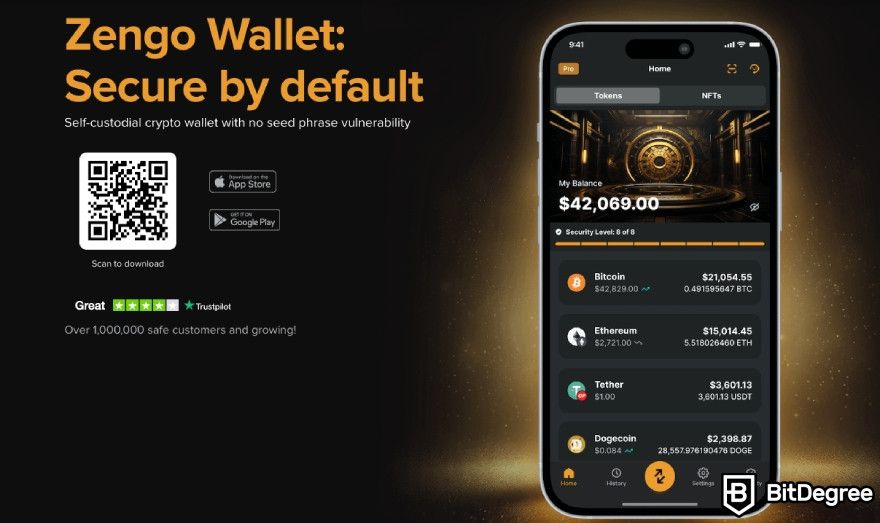
Well…. Kind of. Zengo’s security model is actually rather unique.
Instead of private keys, it employs Multi-Party Computation (MPC) cryptography. In other words, with the wallet in question, you’re not going to have any private keys as they are replaced with two unique signatures - one belongs to you, while the other one is stored on Zengo's servers.
What does this mean to the user? Well, looking through the crypto enthusiast Zengo wallet reviews found online, you’ll learn that, even if your device were to be compromised, with Zengo having the other unique signature, this would add an extra layer of security to your wallet - and a reliable one, at that!
With a very unique approach to private keys and their “replacement”, Zengo is able to remain non-custodial, while still providing certain guarantees to its users, in regard to security. While this is awesome in of itself, it’s actually just scratching the surface.
Major Emphasis on Security
As you might be aware of by now, there are few things in crypto that get as much attention and emphasis placed on them as the topic of security. Even before you acquire your first crypto coin or token, you’ll be hearing about security quite a bit.
And you should, actually! Even with all of the security talk that is present in the space, and the topic being explored and seemingly drilled into newbie crypto enthusiast minds on a constant basis, there are still plenty of horror stories about individuals downloading a keylogger, getting their assets stolen, and all of their accounts compromised.
Evidently, the above statements are especially true in regards to cryptocurrency wallets. Since these pieces of hardware or software (or paper, if that floats your boat) are directly designed to keep your cryptos safe, naturally, they have the brightest part of the spotlight cast on them, as well.
Reading through online user Zengo wallet reviews, it’s evident that this wallet, in particular, is no exception. Multiple people are wondering if it’s a safe option to choose, in general!
Well, let me tell you - from the looks of things, I would have to lean towards the positive side.
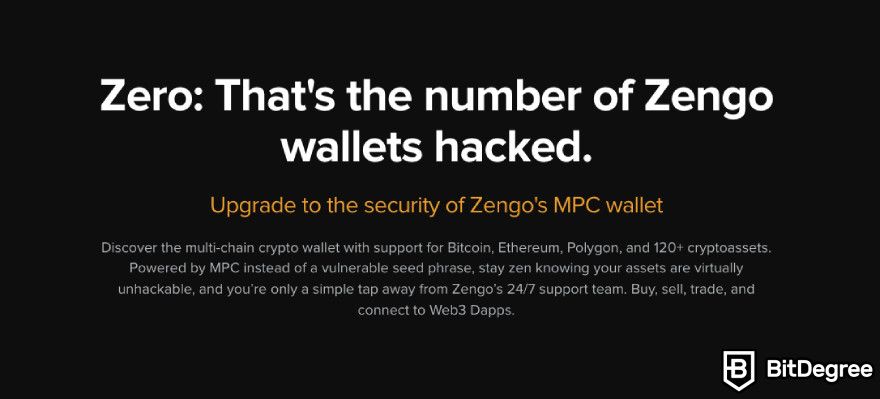
Zengo utilizes a variety of different features in order to guarantee that your assets remain safe and sound. They begin with the above-discussed “keyless wallet” functionality. With two different signatures stored on both your device, as well as Zengo’s servers, the company emphasizes that there remains no single point of failure, thus minimizing the chances of a potential break-in.
In fact, as of writing, no Zengo wallet has ever been hacked. The company even challenged crypto hackers to steal 10 BTC from a specific crypto wallet, but out of over 200 hacking attempts, none was successful.
On top of that, all of your transactions are encrypted, in a specific sense. Meaning, Zengo will not see what you do with your assets - where you send them, trade them, or who you receive them from. All communication happens with the server, and the company does not interfere or have access to this information.
Two major benefits that cannot be ignored are the fact that Zengo cryptography is open-source, as well as that the wallet is constantly being audited. Being open-source, it guarantees that the code behind Zengo’s cryptography is transparent and issue-free, and that it can be checked at any point in time, by anyone who would like to do so.
Furthermore, the frequent audits are also a huge point to consider, as well. They showcase the commitment that Zengo has to keeping its users informed and assured on the services that the wallet provides. This is actually something that isn’t mentioned all that often in user Zengo wallet reviews - a shame!
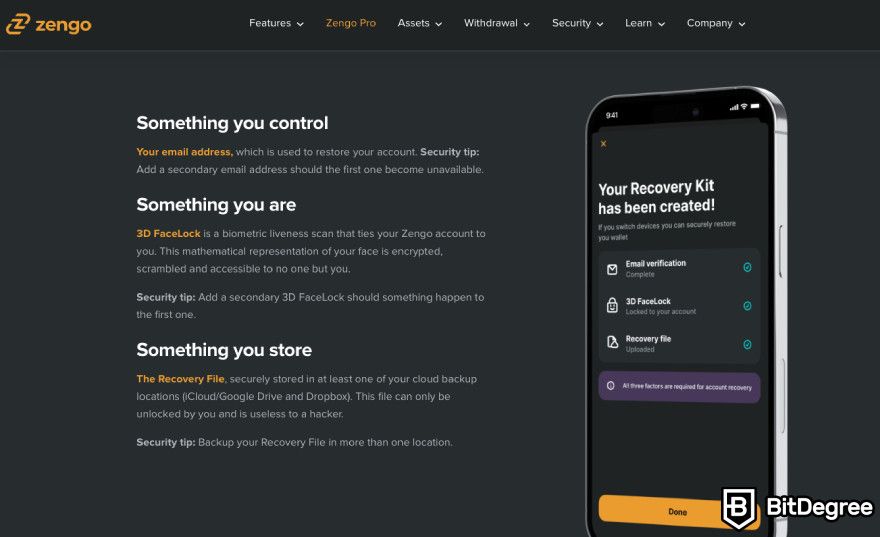
Moving on towards some of the more-tangible (in a specific sense) security benefits, the most notable feature of Zengo is the fact that it employs three-factor authentication (3FA).
For one, Zengo requires all users to confirm their wallet sign-ins via email. A very simple solution, however, if your email doesn’t get compromised, a very effective one, too!
Moreover, it has the 3D FaceLock, so your sign-ins happen via biometric face scanning (it's optional as a password, but mandatory for recovery). In other words, unless a hacker has an identical face to yours, they aren’t going to be able to access your wallet.
Lastly, there is the Zengo Recovery File, which utilizes the Cloud. It allows you to recover your account even if you lose your phone, accidentally delete your app, or purchase a new phone and install the Zengo wallet app.
No matter how you look at it, one thing’s for sure - as far as this Zengo review is concerned, the wallet does definitely put a huge emphasis on all-things-security. A very important point to keep in mind!
Latest Ledger Nano X Coupon Found:For a limited time only, get Top-rated Ledger bundles for yourself and your loved ones with a 10% Ledger discount code. Take advantage of this valuable Ledger deal NOW!
Crypto Staking Functionality
Moving away from security features, Zengo does actually have some other unique benefits to offer to its users, too. It wouldn’t actually be a thorough Zengo wallet review without mentioning the fact that the product allows you to earn an APY or APR on the assets that you store in your wallet.
Well, to be more specific, you can earn an APY on Ethereum (ETH) and an APR on Tezos (XTZ). In the past, Zengo allowed earning an APY for simply storing BTC and planned on expanding its APY-earning list to include USDC, USDT, DAI, and NEXO. However, as of writing, it only supports the two aforementioned assets.
How does this earning process work, though?
To put things simply, all that you need to do is store your ETH or XTZ in the Zengo wallet and then activate the earning feature. For any amount of Ethereum that you start staking, you will be able to earn an APY of up to 8%. You cannot use the staked ETH, but you can withdraw it at any time and the rewards are automatically credited every few days.
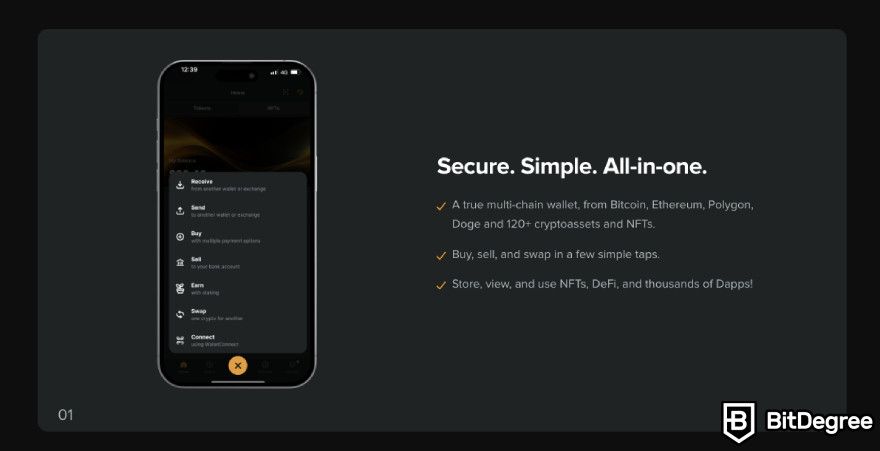
As for XTZ staking, there is a variable APR, which changes with every reward cycle (for example, as of writing, it's 5,32%). Unlike with ETH staking, you'll have a 36-day waiting period before you get your first reward for XTZ staking. After that, you'll start receiving the rewards every few days (which are referred to as "reward cycles").
Cryptocurrency wallets that allow you to earn an interest on your assets aren’t the norm - far from it! This is actually a rather unique feature offered by Zengo. On top of being able to store your cryptos in a secure environment, you will also be able to earn an interest on them - that’s awesome!
By the way, if you worry about Zengo's usability – don't. While it does have some unique offerings, it's very user-friendly. Also, if you face any issues, there's a 24/7 live customer support team that's always on standby.
Swap Cryptocurrencies Inside Your Wallet
Whenever you hear the term “cryptocurrency wallet”, chances are that your first inclination is to imagine a place where you could store your cryptos, as well as send or receive them, too.
Well, as time goes on, more and more wallets allow their users to both trade (or swap) and purchase cryptocurrencies without leaving the wallet environment itself. Multiple user Zengo wallet reviews will tell you that this is the case with the product in question, too.
Zengo allows you to swap crypto within the wallet interface via the Zengo Swap, which is made possible via their partnership with Changelly. Above all, this results in a major win for convenience - you don’t need to visit an exchange, purchase your cryptos there, and then send them to your wallet.
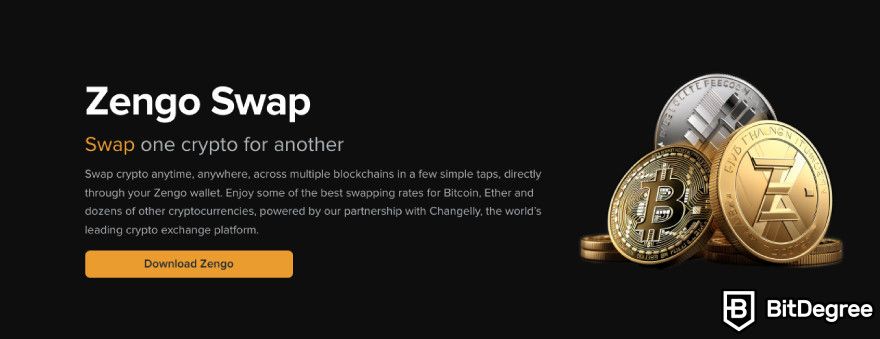
While this does have its own pros and cons, convenience-wise, being able to buy and swap cryptocurrencies within the wallet itself is awesome.
As for buying crypto with fiat, Zengo has a crypto on- / off-ramp integration that allows you to pay for crypto with fiat using various payment channels, namely Banxa, MoonPay (only for non-US users), Ramp, Coinmama, and Transak.
That’s not where the benefits end, however. Multiple trade functionality-possessing wallets have some above-average fees associated with them - this can often discourage potential users from trading and buying crypto on the wallet, and make them turn towards some of the more fee-friendly exchange platforms out there.
However, with Zengo, this isn’t exactly an issue; its fees are pretty decent.
Over 180 Supported Crypto Assets
Whilst discussing cryptocurrency wallets, it would be impossible not to take a look at one of the core features that are, naturally, exceptionally important for most people who are looking for a storage option for their assets - coin and token support.
Some crypto wallets are dedicated products - what this means is that they only support a set specific cryptocurrency, and are aimed at the holders of that currency. This actually used to be the norm for the longest time, too!
As the industry advanced, though, multi-currency wallets have started popping up left, right, and center. Zengo is one such wallet, too.
If you read through this Zengo wallet review, and decide that you want to try the platform out for yourself, note that Zengo is a multi-chain wallet that allows you to store over 180 different crypto assets, including coins, tokens, and NFTs.
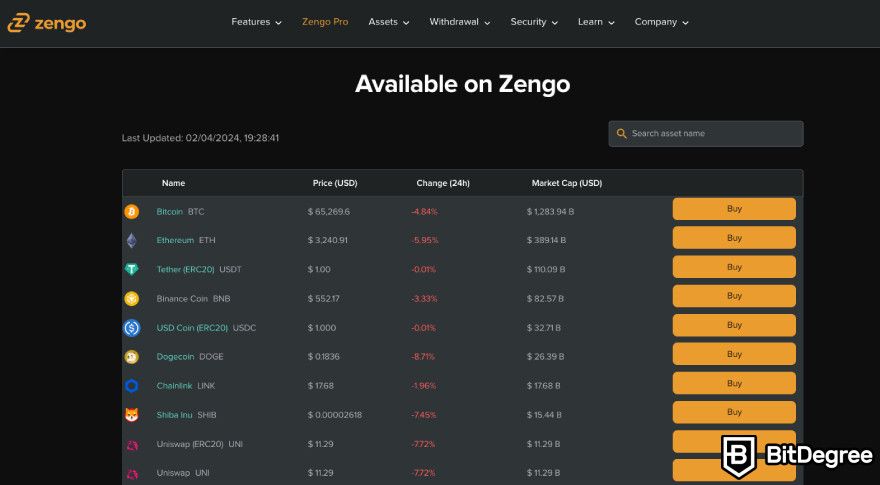
That’s actually a large number, too! It includes all of the main coins that you’d come to expect to be supported, as well as some of the more-niche assets.
The best part? Zengo is constantly working on improving that number, and allowing wallet users to store an even wider variety of coins. For example, Zengo has the SHIB token support, which means you can buy, sell, and trade SHIB using Zengo!
If you’re not looking to become an expert trader with a huge and varied portfolio, this might not be a “groundbreaking benefit” to you. Nonetheless, it’s cool to know that, if you do end up broadening your portfolio at some point in time, you’ll likely be able to store a lot of those assets in the same wallet - Zengo.
By the way, apart from using the Zengo wallet for crypto asset management, you can also use it as a Web3 wallet that allows you to connect to a variety of dApps.
Additional Features with Zengo Pro
Zengo Pro is a premium subscription plan you can activate on your wallet. For $29.99/month (or $199.99/year), you can get some pretty cool additional features.
For example, you can use Legacy Transfer, which allows you to grant access to your assets in the unfortunate event of death or prolonged absence, all while maintaining control in a self-custodial manner. It's an inheritance-like feature, but for crypto. For individuals seeing cryptocurrencies as a life-long (and beyond) investment, Legacy Transfer provides a hassle-free, effortless way for your loved ones to receive your assets.
Moreover, Zengo Pro introduces Theft Protection, employing 3D FaceLock biometric verification to prevent unauthorized withdrawals above a specified amount. This feature protects from SIM swap, device theft, and device takeovers. Also, the subscription plan activates the Advanced Web3 Firewall, providing real-time risk assessments and alerts to keep your assets safe.

Now, privacy-conscious users will appreciate the Bitcoin Private Transaction Mode, too. It automatically changes your public Bitcoin wallet address after each transaction, enhancing your anonymity.
In addition to that, Zengo Pro offers up to a 50% discount on fees, ensuring you get the most value out of your transactions. Furthermore, you can enjoy the 24/7 priority support, which ensures speedy response (1 hour or less).
But the perks don't end there. Zengo Pro subscribers receive additional benefits such as a complimentary yearly tax report from CoinLedger, a 3-month free trial of Messari Pro for comprehensive crypto data and research, and a 10% discount on Bankless Citizenship membership, offering exclusive resources and community for crypto enthusiasts.
Zengo Wallet Review: CONS
In addition to 24/7 customer support and a modern UI, I've covered most of the main features and benefits of the product. Now, let’s also cover the less-pretty sides of user Zengo wallet reviews, checking out some shortcomings that may be associated with the wallet in question.
Certain Services Not Available in Some Countries
Disclaimer: Country-specific restriction was a pretty major con in the past, but Zengo has strongly improved in this regard.
Crypto is a topic that’s undoubtedly popular all around the world. No matter where you might reside, chances are that you’ve heard about it, and know someone who’s actively “in it”.
This, in turn, means that wallets are also needed all around the globe. Unfortunately, it’s pretty common for some of the best cryptocurrency wallets on the market (or certain services that these wallets may offer) to not be available in specific countries - Zengo isn’t an exception in that regard. Though, it's not as restricted as it was in the past anymore.
As you might notice in some older Zengo wallet reviews, you were not able to use the crypto purchasing, selling, and trading features of the product if you’re located in the following countries:
- Bangladesh
- Cuba
- Iran
- Ivory Coast
- Myanmar
- North Korea
- Pakistan
- Panama
- South Sudan
- Sudan
- Syria
- Zimbabwe
On top of that, if you resided in one of the following US states, the same denial of service applied to you, too:
- Connecticut
- Hawaii
- New Mexico
- New York
Combined, the list was pretty extensive. While the Zengo wallet itself was supported worldwide, this was little-to-no condolence to anyone who lived in one of the areas mentioned above, and wanted to use all of the features of said wallet.
However, the good news is that Zengo is now available basically anywhere, except for China and a few other countries (it does not list out these "few other countries", but you'll probably be denied access if you try to use Zengo from the restricted regions).

Did you know?
All Crypto wallets may look similar to you but they're NOT all the same!
Zengo's Fee Model
Not many user Zengo wallet reviews talk about the fees associated with the platform in question. However, it’s a very important point that needs to be mentioned.
Fees are an unavoidable part of all-things-crypto. This is actually true no matter if you’re trying to trade cryptocurrencies on an exchange, or send them to your friend.
There are generally two huge types of fees involved - the ones charged by the platform you might be using (wallet, exchange, etc.) and network fees. The former can be adjusted, avoided, and mitigated. The latter CAN be lenient, but they’re much more difficult to circumvent.
Now, the aforementioned platform fees are divided into four more types on Zengo - a processing fee, a spread, a gateway fee, and a local currency conversion fee. All these fees are paid to the operators of the buying, selling, and trading services Zengo offers.
Speaking of those, as you already know, Zengo allows you to purchase cryptocurrencies straight from your wallet thanks to its integrations with Banxa, MoonPay, and Transak. If you want to use your credit card or bank transfer to acquire cryptos, the fees will depend on the aforementioned platforms.
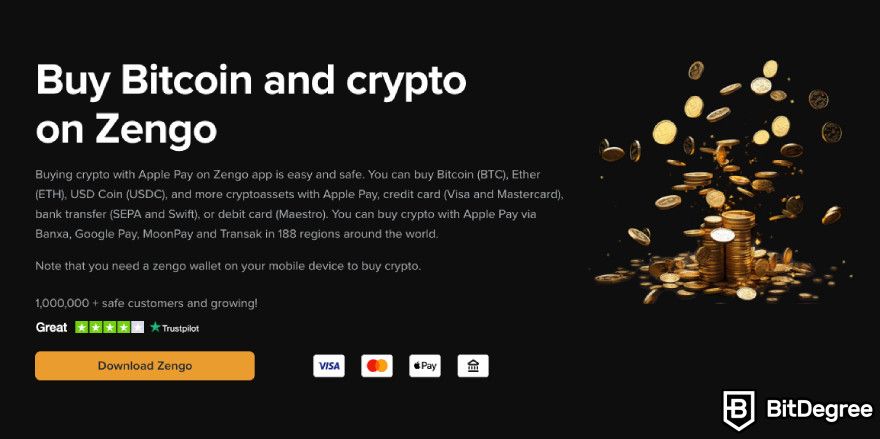
Buying crypto with a credit / debit card or Apple Pay / Google Pay via Banxa can net you 7,74% + a network fee. MoonPay, on the other hand, charges around 8,49%-9,99% + a network fee + a local currency conversion fee (if needed). Then, there's also Transak, which charges 6,69%-7,99% + a network fee.
Now, bank transfer-based crypto buying imposes a bit lower fees. Banxa charges 2,99%-3,29% + a network fee, MoonPay charges 3,49%-5,99% + a network fee + a local currency conversion fee, and Transak charges 4,79%-5,99% + a network fee.
Those are some large numbers. However, they are actually pretty standard for doing things this way. At the same time, they don’t depend on Zengo here - these fees are imposed by the aforementioned platforms.
As far as Zengo is concerned, you can deposit and withdraw most cryptocurrencies completely free of charge, on the wallet’s side of things at least. The only fees associated with these processes are those of the network that you might be using - they are, once again, unavoidable.
If you've read some user Zengo wallet reviews from the past, you would notice that trading cryptocurrencies within the wallet came with a 0,5% flat fee, by default. There was a spread of 1,65% involved, too, but in most cases, it was a bit lower. This applied to Bitcoin, as well - you could send and receive BTC without paying any fees, while purchasing and trading it involved the above-discussed commissions.

That was actually a very decent fee, by comparison! On top of that, with specific crypto assets (Ethereum and ERC-20 tokens), you could choose different fee modes when transacting said assets.
However, the trading fees (or, should I say, swapping fees) are slightly different now. For swapping one crypto for another on Zengo, you'll have to pay up to a 3% processing fee + up to 2% spread + a network fee. The fees differ based on the trading pair in question and a few additional factors.
Though, don't forget that if you subscribe to the Zengo Pro plan (which costs $29.99 if paid monthly), you can get up to 50% off all fees.
You know what’s even more unique? The fact that Zengo allows you to cancel or even speed up your transactions before they are confirmed by the blockchain. There aren’t many crypto wallets that would have such functionality!
All things considered, the fees associated with Zengo are rather decent, especially when compared to some other platforms out there.
How to Use Zengo?
As per tradition, I'll finish off my Zengo wallet review by taking a closer look at how you can set your wallet up, and start using it.
Zengo claims that the registration and setup process shouldn’t take more than 20 seconds. Let’s see if that’s really the case, shall we?
How to Register on Zengo?
Starting off, let’s download the actual app itself. I’ll be using an iPhone device, although the process is extremely similar on Android, too.
Step 1: On your phone, navigate to the Zengo app that you have downloaded.
Step 2: You will be asked to enter your email address, and a referral code, if you have one. Do so.
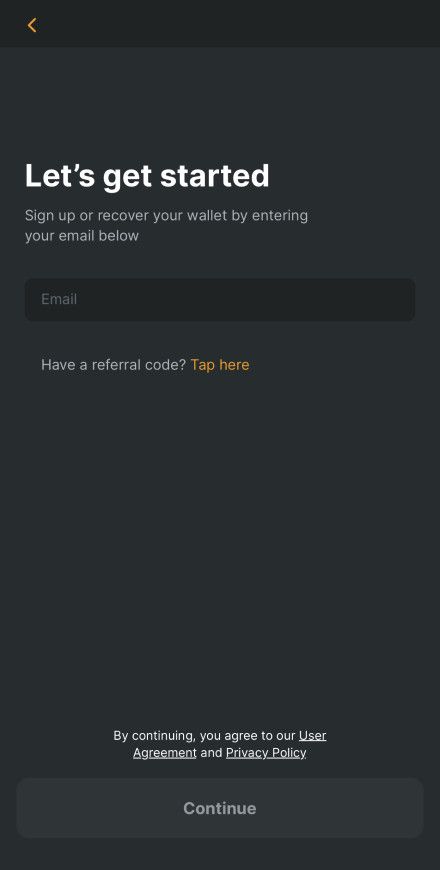
Step 3: Next, you’ll need to confirm your email address. This is a pretty standard process. It has to be done from the same device that you are using Zengo on, though!
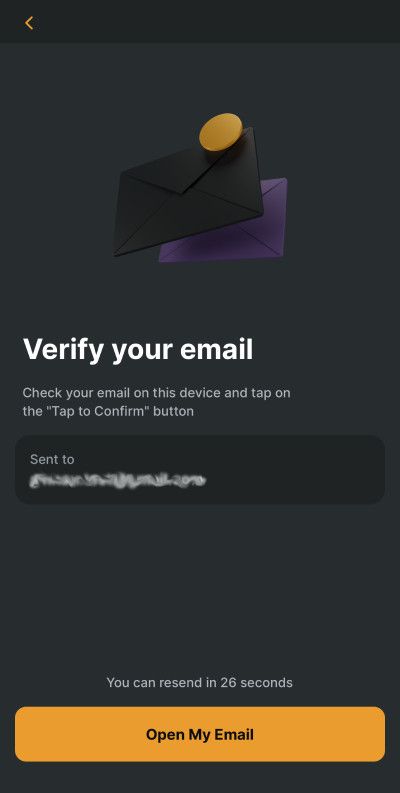
Step 4: Once you confirm your email, your MPC secret share will be generated, and then you will be asked to enable Face ID. This will allow you - and ONLY you - to scan your face, and unlock (enter) the app.
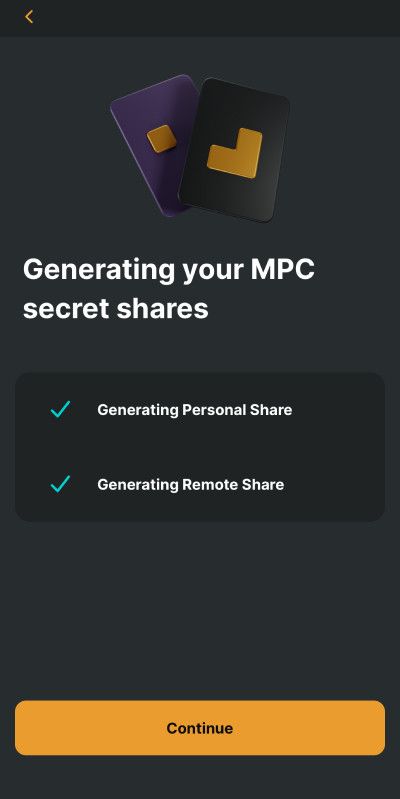
Step 5: Once you do all of that, that’s practically it! You'll now be able to explore the app, check out all of the available features, and set everything up to your liking.

Truth be told, Zengo wasn’t lying - if you have already signed in to your email on your device, the “registration” process is truly super-quick! All that you really need is an email account, and you’re set to go!
How to Send / Receive / Buy / Sell / Swap / Earn Cryptocurrencies on Zengo?
That’s a hefty list of processes, yes. However, all of them can be performed from a single screen on Zengo.
On your wallet, at the bottom menu row, press the button with two arrows. This will take you to a separate screen where you’ll find all of the aforementioned processes.
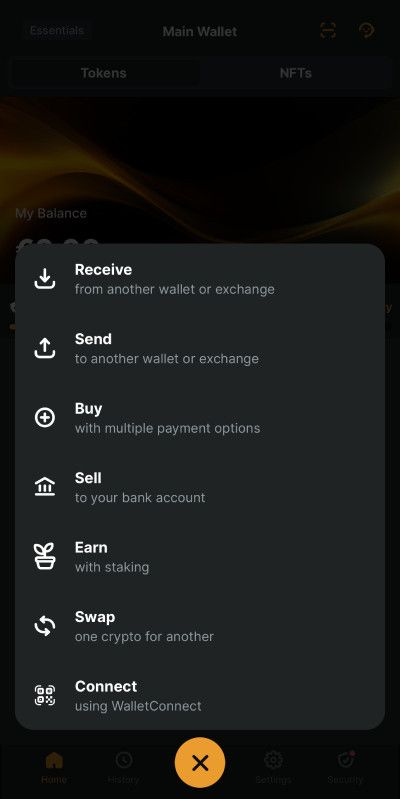
Now, all that you need to do is pick the process that you want to, well… Perform.
Once you do that, though, you'll also be prompted to create your Recovery Kit. Since you've already verified your email, you'll just need to create a 3D FaceLock, which means you'll need to scan your face (no, allowing your Face ID before does not count) and then create a Recovery file. However, when it comes to the latter, you won't do much "creating" yourself, you just need to press a button, and it will be created.
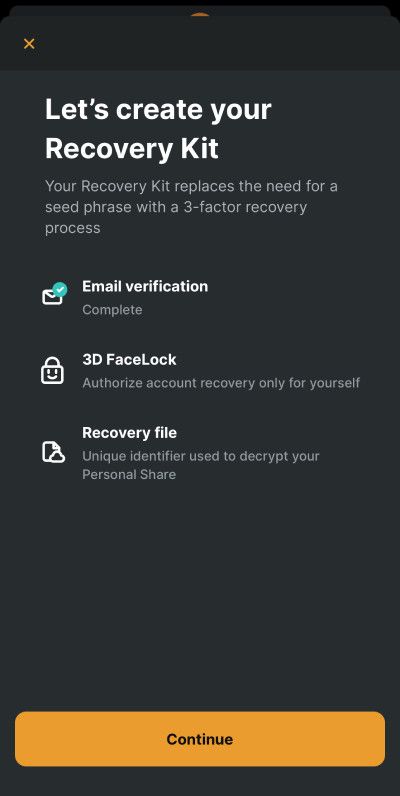
Once that is finished, you can proceed with making the actions you planned to make. If you want to receive cryptocurrencies, you’ll need to choose the crypto you’d like to receive, press a few buttons, and a wallet address will be generated for you - the process is the same as with any other major multi-currency wallet out there.
From here, you may also swap, send, buy, sell, and earn cryptos, too. Earning them references to the staking functionality of Zengo - you simply start staking either ETH or XTZ and earn a passive yield over time.
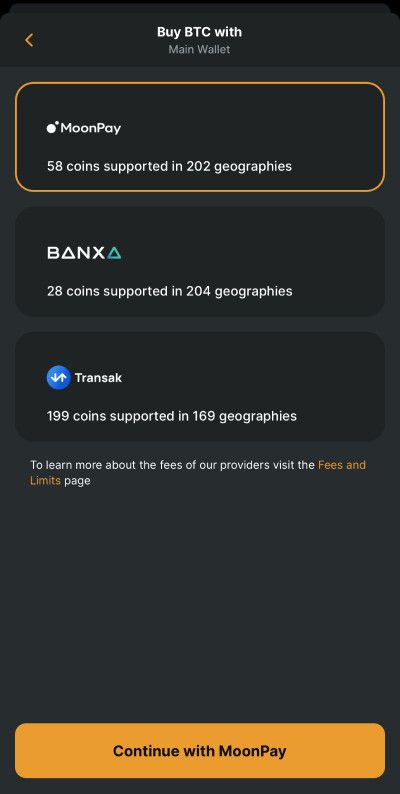
Now, if you want to buy crypto, as I've already discussed earlier in the Zengo wallet review, you’ll be able to do so via Banxa, MoonPay, or Transak. The process is very self-explanatory, and Zengo does a good job of guiding you through it, too!
All in all, no matter which process it is that you choose to partake in with Zengo, you shouldn’t face any difficulties, whatsoever!

- User-friendly design
- Robust security
- Long battery life

- A brand-new design
- Industry-leading security
- Coin, token and NFT storage

- Supports 1,000+ crypto assets
- Easy navigation
- Open-source
Conclusions
To conclude this Zengo wallet review, I have to say - while the wallet in question may not be the most popular hot storage solution on the market, with the features that it has available at this time, combined with those yet to come, it might definitely become one!
Zengo is a very interesting piece of software, and has a whole lot to offer to its users. I've covered all the main benefits that you can expect to receive while using this platform, but there are new and improved features that are constantly being added to the wallet.
If you’re looking for a reliable cryptocurrency wallet product, and aren’t too keen on purchasing hardware wallets or using some of the better-known hot storage options, Zengo might fit you perfectly.
At the same time, do keep in mind that the wallet employs a rather non-traditional security model, and some of its services aren't going to be available in certain countries. If these things don’t bother you, make sure to check Zengo out!
The content published on this website is not aimed to give any kind of financial, investment, trading, or any other form of advice. BitDegree.org does not endorse or suggest you to buy, sell or hold any kind of cryptocurrency. Before making financial investment decisions, do consult your financial advisor.






